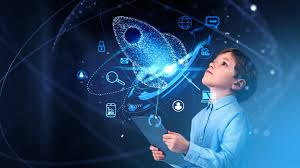The Impact of Technology in Education
Technology has revolutionized the way we learn and teach in the modern world. With the integration of digital tools and resources, education has become more accessible, engaging, and effective than ever before.
One of the key benefits of technology in education is its ability to personalize learning experiences. With online platforms, adaptive learning software, and educational apps, students can learn at their own pace and focus on areas where they need improvement.
Furthermore, technology has made learning more interactive and collaborative. Virtual classrooms, video conferencing tools, and online discussion forums enable students to engage with their peers and instructors from anywhere in the world.
Another significant advantage of technology in education is the wealth of information available at our fingertips. The internet provides a vast repository of knowledge that students can access to supplement their learning and conduct research on various topics.
Moreover, technology has made education more inclusive by providing opportunities for remote learning. Students who are unable to attend traditional classes due to geographical constraints or physical disabilities can now access quality education through online programs and resources.
Despite these benefits, it is essential to acknowledge that technology should be used thoughtfully and responsibly in education. It is crucial for educators to integrate technology into their teaching practices in a way that enhances learning outcomes without compromising the integrity of education.
In conclusion, the use of technology in education has transformed the way we teach and learn, making education more accessible, engaging, and personalized. By leveraging digital tools and resources effectively, we can empower students to reach their full potential and prepare them for success in a rapidly evolving digital world.
6 Essential Tips for Maximizing Technology in Education
- Utilize interactive multimedia resources to enhance engagement and understanding.
- Encourage collaboration through online platforms for group projects and discussions.
- Provide personalized learning experiences using adaptive technology and analytics.
- Incorporate gamification elements to make learning more enjoyable and motivating.
- Ensure digital literacy by teaching students how to effectively navigate and evaluate online information.
- Regularly assess the effectiveness of technology integration in education to make informed decisions.
Utilize interactive multimedia resources to enhance engagement and understanding.
By utilizing interactive multimedia resources in education, educators can significantly enhance student engagement and understanding. These dynamic tools allow students to interact with content in a more immersive and hands-on way, making learning experiences more stimulating and effective. From videos and simulations to virtual reality applications, interactive multimedia resources cater to different learning styles and help reinforce concepts through visual and auditory stimuli. By incorporating these engaging resources into their teaching practices, educators can create a more interactive and enriching learning environment that fosters deeper comprehension and retention of knowledge.
Encourage collaboration through online platforms for group projects and discussions.
Encouraging collaboration through online platforms for group projects and discussions is a valuable tip for leveraging technology in education. By utilizing digital tools that facilitate teamwork and communication, students can engage with their peers in a virtual setting, fostering a sense of community and enhancing their collaborative skills. Online platforms provide a space for students to share ideas, work together on projects, and participate in discussions regardless of physical location, promoting inclusivity and active learning. This approach not only enhances the learning experience but also prepares students for real-world collaboration in an increasingly digital-centric society.
Provide personalized learning experiences using adaptive technology and analytics.
By utilizing adaptive technology and analytics, educators can offer personalized learning experiences that cater to individual student needs and preferences. This approach allows students to learn at their own pace, focus on areas where they need additional support, and engage with content that is tailored to their learning styles. By leveraging data-driven insights from analytics, educators can track student progress, identify areas for improvement, and adjust teaching strategies accordingly. This personalized approach not only enhances student engagement and motivation but also fosters a deeper understanding of the subject matter, ultimately leading to improved learning outcomes.
Incorporate gamification elements to make learning more enjoyable and motivating.
By incorporating gamification elements into educational practices, learning can be transformed into a more enjoyable and motivating experience for students. Gamification techniques, such as rewards, challenges, and interactive gameplay, not only make learning fun but also encourage active participation and engagement. By tapping into the inherent desire for competition and achievement, educators can leverage gamification to enhance student motivation, boost retention of information, and foster a positive learning environment where students are eager to learn and succeed.
Ensure digital literacy by teaching students how to effectively navigate and evaluate online information.
To enhance the use of technology in education, it is crucial to prioritize digital literacy by teaching students how to effectively navigate and evaluate online information. By equipping students with the skills to discern credible sources, verify information accuracy, and identify potential biases, educators empower them to make informed decisions and think critically in the digital age. This emphasis on digital literacy not only enhances students’ research abilities but also cultivates a sense of responsibility and awareness in consuming information online.
Regularly assess the effectiveness of technology integration in education to make informed decisions.
Regularly assessing the effectiveness of technology integration in education is crucial for making informed decisions that enhance the learning experience. By evaluating how technology is being used in the classroom, educators can identify what works well and what areas may need improvement. This feedback loop allows for adjustments to be made proactively, ensuring that technology is being leveraged to its full potential to support student learning and engagement.
Tags: adaptive learning software, adaptive technology, analytics, collaboration, collaborative, digital tools, discussions, education, educational apps, group projects, impact, inclusive education, interactive, interactive multimedia resources, online platforms, personalized learning, personalized learning experiences, remote learning, resources, student engagement, technology, understanding, use of technology in education, virtual classrooms, virtual reality applications
